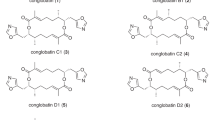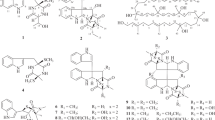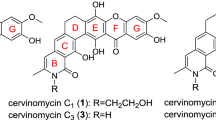Abstract
Three novel antitrypanosomal alkaloids, named spoxazomicins A–C, were isolated by silica gel column chromatography and HPLC from the culture broth of a new endophytic actinomycete species, Streptosporangium oxazolinicum K07-0460T. The structures of the spoxazomicins were elucidated by NMR and X-ray crystal analyses and shown to be new types of pyochelin family antibiotic. Spoxazomicin A showed potent and selective antitrypanosomal activity with an IC50 value of 0.11 μg ml−1 in vitro without cytotoxicity against MRC-5 cells (IC50=27.8 μg ml−1).
Similar content being viewed by others
Introduction
It has become more and more difficult to find new bioactive compounds derived from actinomycete strains isolated from soils, so the focus of attention has switched to find novel actinomycetes from other sources. We have studied endophytic actinomycetes as the producers of new bioactive compounds. On the other hand, we have identified several useful microbial metabolites, such as staurosporine, pyrindicin and dityromycin by a chemical screening approach to detect alkaloids using Dragendorff’s reagent.1, 2, 3 In the course of chemical screening for alkaloids from the culture broths of endophytic actinomycetes, we have now discovered three new alkaloid antibiotics, spoxazomicins A–C (1–3) (Figure 1), produced by a new actinomycete species, Streptosporangium oxazolinicum K07-0460T isolated from an orchid collected in Okinawa prefecture, Japan. Spoxazomicins A (1) and B (2) exhibit antitrypanosomal activities in vitro. We report here the fermentation, isolation, physico-chemical properties and structural elucidation of 1–3. We also report the antitrypanosomal profiles of 1–3 (Figure 1) and discuss structure-activity relationships. The taxonomic study of the spoxazomicin producing strain will be reported in the accompanying paper.4
Results
Isolation
The procedure for isolation of 1–3, using the Dragendorff reaction, is summarized in Scheme 1. The 4-day-old culture broth (8.4 l) was added with 8.4 l of ethanol, followed by centrifugation at 3000 r.p.m. The supernatant was concentrated under reduced pressure to remove ethanol and then adjusted to pH 9 with aqueous ammonia followed by extraction with 4.0 l of n-butyl acetate. The organic layer was partitioned with 0.1 M hydrochloric acid (2.0 l). The water layer was subsequently adjusted to pH 9 with aqueous ammonia and extracted with 2.0 l of ethtyl acetate. The ethyl acetate extract (211.0 mg) was chromatographed on silica gel (20φ × 70 mm, 0.063–0.200 mm, Merck, Darmstadt, Germany) eluting with a solvent mixture of chloroform and methanol (100:0 v/v (140 ml) and 50:1, v/v (70 ml)). Each fraction was concentrated in vacuo to dryness to yield 40.6 and 78.3 mg of crude materials, respectively. The material of fraction 100:0 was purified by HPLC on a Pegasil ODS column (20φ × 250 mm, Senshu Scientific, Tokyo, Japan) with 10% acetonitrile/0.1% TFA at 8 ml min−1 detected at UV 210 nm. The fraction eluted at 18.5 min was concentrated in vacuo to dryness to afford 3 (36.1 mg) as white powder. The material of fraction 50:1 (78.3 mg) was purified by HPLC on a Pegasil ODS column (20φ × 250 mm) with 45% acetonitrile at 8 ml min−1 detected at UV 210 nm. The fractions eluted at 20.1 and 23.3 min were concentrated in vacuo to dryness to afford 2 (5.3 mg) and 1 (24.4 mg), both as white powders.
Physico-chemical properties
The physico-chemical properties of 1–3 are summarized in Table 1. They were readily soluble in methanol and chloroform. They showed absorption maxima at 208, 244 (or 248) and 304 nm in UV spectra. The broad IR absorption at 3400 cm−1 suggested the presence of hydroxyl groups.
Structure elucidation of spoxazomicin A (1)
The molecular formula of 1 was elucidated by HR-FAB-MS to be C16H21N3O3S, requiring 8 degrees of unsaturation. The 1H and 13C NMR spectral data of 1 are listed in Table 2. The 13C NMR and HSQC spectra indicated 16 carbons, which were classified into one amide carbonyl carbon at δC 173.5, three sp2 quaternary carbons, four sp2 methine carbons, three sp3 methine carbons, one oxygenated sp3 methylene carbon at δC 70.8, two sp3 methylene carbons, one N-methyl carbon at δC 43.1 and one acetyl methyl carbon at δC 22.6. The 1H NMR spectrum indicated the presence of one 1,2-disubstituted benzene (δH 7.64 (1H, dd, J=0.9, 7.7), 7.38 (1H, ddd, J=0.9, 7.3, 8.2), 6.94 (1H, br. d, J=8.2) and 6.88 (1H, br. dd, J=7.3, 7.7)). In the 1H-1H COSY experiment, the spin system from 3′-H to 6′-H was confirmed and two other spin systems of 5-H-4-H-2′′-H and from 5′′-H-4′′-H-6′′-H were deduced (Figure 2). The HMBC correlations from 3′-H to C-1′ and from 4′-H to C-2′ and the chemical shift at C-2′ (δC 161.1) indicated the presence of a 2-hydroxyphenyl moiety. The HMBC correlations from 4-H and 5-H2 to C-2, from 5′′-H2 to C-2′′, from 6′′-H2 and 9′′-H3 to C-8′′ and from 10′′-H3 to C-2′′ and C-4′′ indicated the presence of a 4-[4-(acetylamino)methyl-3-methyl-2-thiazolidinyl]-4,5-dihydrooxazole moiety. These two fragments were connected based on the HMBC correlations from 6′-H to C-2 (Figure 2). Thus, the structure of 1 is elucidated as a new type of pyochelin family antibiotics, and 1 was designated as spoxazomicin A (Figure 1).
The relative configuration of 1 was elucidated by differential NOE experiments (Figure 3). The observed NOE correlations between 4-H and 6′′-H, between 2′′-H and 10′′-H3, between 4′′-H and 10′′-H3 and between 5-H and 2′′-H confirmed that 2′′-H and 4′′-H were on the α-face of the molecule, and the relative configuration of 1 was suggested as 4R*, 2′′S*, 4′′S*.
Structure elucidation of spoxazomicin B (2)
The molecular formula of 2 was elucidated by HR-FAB-MS to be C16H21N3O3S, similar to that of 1. The 1H and 13C NMR spectral data of 2 are listed in Table 2. The 1H and 13C NMR spectra of 2 were very similar to those of 1. The analysis of 2D NMR spectra revealed that the planar structure of 2 was identical with 1, and thus 2 was suggested to be a diastereomer of 1 and designated as spoxazomicin B (Figures 1 and 2).
The relative configuration of 2 was elucidated by differential NOE experiments (Figure 3). The observed NOE correlations between 4-H and 4′′-H confirmed that 2′′-H and 4′′-H were on the β-face and α-face of the molecule, respectively. The relative configuration of 2 was suggested as 4R*, 2′′R*, 4′′S*, and 2 was shown to be an epimer at the thioaminal carbon of 1, which was supported by gradually isomerization between 1 and 2 in solution.
Structure elucidation of spoxazomicin C (3)
The molecular formula of 3 was elucidated by HR-EI-MS to be C10H11NO3, requiring 6 degrees of unsaturation. The 1H and 13C NMR spectral data of 3 are listed in Table 2. The 13C NMR and HSQC spectra indicated 10 carbons, which were classified into three sp2 quaternary carbons, four sp2 methine carbons, one sp3 methine carbon and two sp3 methylene carbons. The 1H and 13C NMR spectra of 3 were similar to those of the 2-phenyl-4,5-dihydrooxazole moiety of 1. The 2D NMR spectra indicated that the structure of 3 was as shown in Figure 2 and 3 was designated as spoxazomicin C. The structure was confirmed by single-crystal X-ray crystallographic analysis using the crystals obtained from a mixed solution of EtOAc/hexane (1:3). The ORTEP drawing is shown in Figure 4.
Biological activities
In vitro antitrypanosomal activities of 1–3 were evaluated together with the activities of some standard antitrypanosomal drugs (Table 3). Among the tested spoxazomicins, 1 showed the highest antitrypanosomal activity against the GUTat 3.1 strain of T. b. brucei, with an IC50 value of 0.11 μg ml−1, which has 14–21-fold more potent activity than those of the clinically used antitrypanosomal drugs, suramin and eflornithine. Compound 2 also showed comparatively potent antitrypanosomal activity, with an IC50 value of 0.55 μg ml−1, but 3 showed weak antitrypanosomal activity, with an IC50 value around 3 μg ml−1.
The cytotoxicity of spoxazomicins was evaluated against a human diploid embryonic cell line (MRC-5). The compounds 1 and 2 were weakly cytotoxic with IC50 values of 21–28 μg ml−1, and 3 showed an IC50 value of 14 μg ml−1. To compare the overall antitrypanosomal activity and cytotoxicity, we introduced a selectivity index (SI: cytotoxicity (IC50 for the MRC-5 cells)/antitrypanosomal activity (IC50 for the GUTat 3.1 strain)), as presented in Table 3. The SI of 1 was the highest, with a ratio of 253. Compound 2 showed a medium SI, with the ratio of 38, whereas 3 showed the lowest SI with a ratio of 3.8.
Compounds 1–3 showed no antibacterial and antifungal activities at 10 μg on the paper disc method against the following microorganisms: Staphylococcus aureus (ATCC6538p), Bacillus subtilis (ATCC6633), Kocuria rhizophila (ATCC9341), Mycobacterium smegmatis (ATCC607), Escherichia coli NIHJ (KB213), Escherichia coli NIHJ JC-2 (IFO12734), Pseudomonas aeruginosa (IFO3080), Xanthomonas campestris pv. oryzae (KB88), Proteus mirabilis (NBRC3849), Proteus vulgaris (NBRC3167), Bacteroides fragilis (ATCC23745), Candida albicans (KF1), Saccharomyces cerevisiae (ATCC9763), Aspergillus niger (ATCC6275), Pyricularia oryzae (KF180) and Mucor racemosus (IFO4581).
Discussion
We have isolated new types of pyochelin family antibiotics (1–3) from a new endophytic actinomycete species, Streptosporangium oxazolinicum K07-0460T. Antitrypanosomal activity of 1 and 2 was much more potent and selective than 3. Therefore, the 4-(acetylamino)methyl-3-methyl-2-thiazolidine moiety might be important for conferring activity and selectivity. The antitrypanosomal activities of 1 was substantially more potent than 2, which suggested the S* configuration of C-2′′ might have a significant role.
Pyochelin family antibiotics have been reported to have various activities. Pyochelin was an iron-chelating growth promoter for Pseudomonas aerginosa.5 Thiazostatins A and B had antioxidant activities.6 Watasemycins A and B had anti-Proteus mirabilis activity and weak antibacterial activities against some Gram-positive bacteria.7 However, this is the first report of antitrypanosomal activities of pyochelin family antibiotics. The results reveal that 1 and 2 are the promising lead compounds for developing a new type of antitrypanosomal drugs. Further investigations of the antitrypanosomal and other biological activities of 1–3 are in progress.
Methods
General
1H, 13C and 2D NMR spectra were measured in CD3OD using a Varian XL-300 spectrometer (Varian, Palo Alto, CA, USA). NOE experiments were measured using a Varian Inova 600 spectrometer. Chemical shifts were expressed in p.p.m. and were referenced to CD3OD (3.31 p.p.m.) in the 1H NMR spectra and to CD3OD (49.0 p.p.m.) in the 13C NMR spectra. FAB-MS and EI-MS spectra were measured on a JEOL JMS AX-505 HA mass spectrometer (JEOL, Akishima, Japan). IR spectra (KBr) were taken on a Horiba FT-210 Fourier transform Infrared spectrometer (Horiba, Kyoto, Japan). UV spectra were measured with a Beckman DU640 spectrophotometer (Beckman, Fullerton, CA, USA). Optical rotation was measured on a JASCO model DIP-181 polarimeter (JASCO, Hachioji, Japan). X-ray crystal analysis was measured on a RASA-5R (Rigaku, Akishima, Japan).
Fermentation
The strain K07-0460 was grown and maintained on the agar slant containing starch 1.0%, NZ amine 0.3%, yeast extract 0.1%, meat extract 0.1%, CaCO3 0.3% and agar 1.5 % (adjusted to pH 7.0 before sterilization). A loop of cells of strain K07-0460 was inoculated into 10 ml of seed medium consisting of starch 2.4%, glucose 0.1%, peptone 0.3%, meat extract 0.3%, yeast extract 0.5% and CaCO3 0.3% (adjusted to pH 7.0 before sterilization) in a test tube. The test tube was incubated on a rotary shaker (300 r.p.m.) at 27 °C for 6 days. A 1-ml portion of the first seed culture was transferred to a 500-ml Erlenmeyer flask containing 100 ml of the seed medium (the same components described above), and the fermentation was carried out on a rotary shaker (210 r.p.m.) at 28 °C for 3 days.
For production of 1–3, a 1-ml portion of the second seed culture was transferred to 500-ml Erlenmeyer flasks (total 42 flasks), each containing 200 ml of production medium (the same components as the seed medium), and the fermentation was carried out on a rotary shaker (210 r.p.m.) at 28 °C for 4 days.
Antitrypanosomal and cytotoxic activity in vitro
In vitro antitrypanosomal activities against Trypanosoma brucei brucei strain GUTat 3.1 and cytotoxicity against human diploid embryonic cell line MRC-5 were measured as described previously.8
Antimicrobial activity
Antimicrobial activity was measured by a paper disk method (6 mm, Advantec, Tokyo, Japan) as described previously.9
Crystallographic analysis
The crystal contained two molecules of 3, 2(C10H11NO3), was the monoclinic space group C2(#5) with a=28.736(5) Å, b=4.714(4) Å, c=14.117(6) Å, β=90.0000°, V=1912(1) Å3, Z=8, dcalcd=1.342 g cm−3, μ=8.35 cm−1 and T=296 K. X-ray intensity data were collected on a Rigaku AFC5R diffractometer employing graphite-monochromated Cu Kα radiation (λ=1.54178 Å) and the ω-2θ scan technique. The structure was solved by direct methods. For refinement, 2070 unique reflections with F2>2.0σ(F2) were used. Full-matrix least-squares refinement were based on F2, minimizing the quantity Σw(Fo2-Fc2)2 with w=1/σ2 (Fo2), GOF=1.20, R1=0.052 and Rw=0.152. Crystallographic data of 3 has been deposited with the Cambridge Crystallographic Data Centre as supplementary publication number CCDC 812009. Copies of the data can be obtained, free of charge, on application to CDCC, 12 Union Road, Cambridge CB2 1EZ, UK (Fax: C44(0)-1223-336033 or E-mail: deposit@ccdc.cam.ac.uk).

Isolation procedure for spoxazomicins A-C (1-3).
References
Ōmura, S. et al. A new alkaloid AM-2282 of Streptomyces origin. Taxonomy, fermentation, isolation and preliminary characterization. J. Antibiot. 30, 275–282 (1977).
Ōmura, S. et al. Pyrindicin, a new alkaloid from Streptomyces strain. Agric. Biol. Chem. 38, 899–906 (1974).
Ōmura, S. et al. A new antibiotic, AM-2504. Agric. Biol. Chem. 41, 1827–1828 (1977).
Inahashi, Y., Matsumoto, A., Ōmura, S. & Takahashi, Y. Streptosporangium oxazolinicum sp. nov., a novel endophytic actinomycete producing new antitrypanosomal antibiotics, spoxazomicins. J. Antibiot. (e-pub ahead of print; doi:10.1038/ja.2011.18).
Cox, C. D., Rinehart, K. L. Jr, Moore, M. L. & Cook, J. C. Pyochelin: novel structure of an iron-chelating growth promoter for Pseudomonas aeruginosa. Proc. Natl Acad. Sci. USA 78, 4256–4260 (1981).
Shindo, K., Takenaka, T., Noguchi, T., Hayakawa, Y. & Seto, H. Thiazostatin A and thiazostatin B, new antibiotics produced by Streptomycestolurosus. J. Antibiot. 42, 1526–1529 (1989).
Sasaki, T., Igarashi, Y., Saito, N. & Furumai, T. Watasemycins A and B, new antibiotics produced by Streptomyces sp. TP-A0597. J. Antibiot. 55, 249–255 (2002).
Otoguro, K. et al. Selective and potent in vitro antitrypanosomal activities of 10 microbial metabolites. J. Antibiot. 61, 372–378 (2008).
Inokoshi, J. et al. Funalenone, a novel collagenase inhibitor produced by Aspergillus niger. J. Antibiot. 52, 1095–1100 (1999).
Acknowledgements
This work was supported, in part, by funds from the Drugs for Neglected Diseases initiative (DNDi), Quality Assurance Framework of Higher Education from the Ministry of Education, Culture, Sports, Science and Technology, Japan (MEXT), the Institute for Fermentation, Osaka (IFO), Japan and the All Kitasato Project Study (AKPS). We are grateful to H Sekiguchi and T. Furusawa for their technical assistance and to Akiko Nakagawa, Noriko Sato and Kenichiro Nagai, School of Pharmacy, Kitasato University for measurements of mass and NMR spectra.
Author information
Authors and Affiliations
Corresponding authors
Rights and permissions
About this article
Cite this article
Inahashi, Y., Iwatsuki, M., Ishiyama, A. et al. Spoxazomicins A–C, novel antitrypanosomal alkaloids produced by an endophytic actinomycete, Streptosporangium oxazolinicum K07-0460T. J Antibiot 64, 303–307 (2011). https://doi.org/10.1038/ja.2011.16
Received:
Revised:
Accepted:
Published:
Issue Date:
DOI: https://doi.org/10.1038/ja.2011.16
Keywords
This article is cited by
-
Theoretical implications on the [3 + 2] cycloaddition reactions of dibromoformaldoxime and (Z)-, (E)-3-(4-chlorobenzylidene)-1-methylindolin-2-one in terms of FMO, MEDT, and distortion-interaction theories
Structural Chemistry (2023)
-
Phylogenetic affiliation and antimicrobial effects of endophytic actinobacteria associated with medicinal plants: prevalence of polyketide synthase type II in antimicrobial strains
Folia Microbiologica (2019)
-
Characterisation of Two Polyketides from Streptomyces sp. SKH1-2 Isolated from Roots of Musa (ABB) cv. ‘Kluai Sao Kratuep Ho’
International Microbiology (2019)







